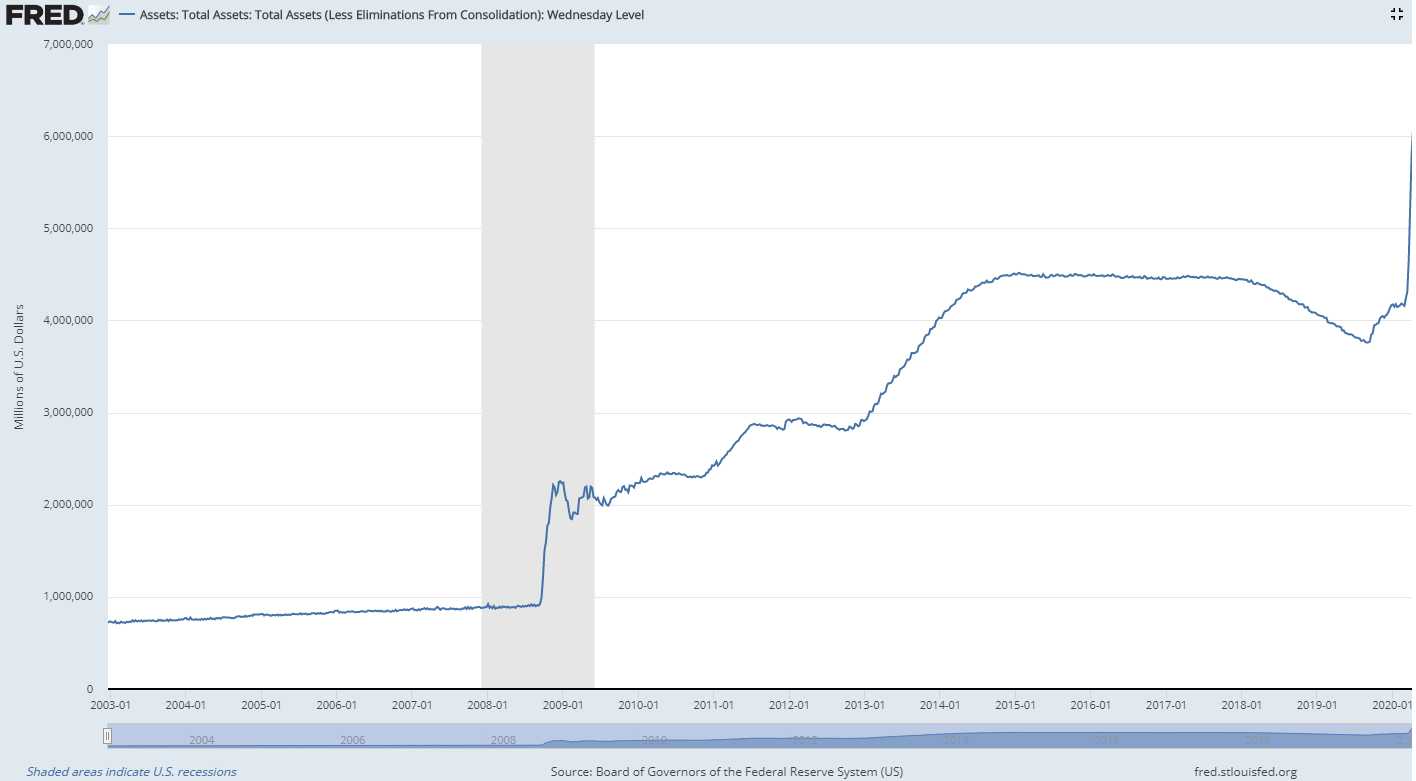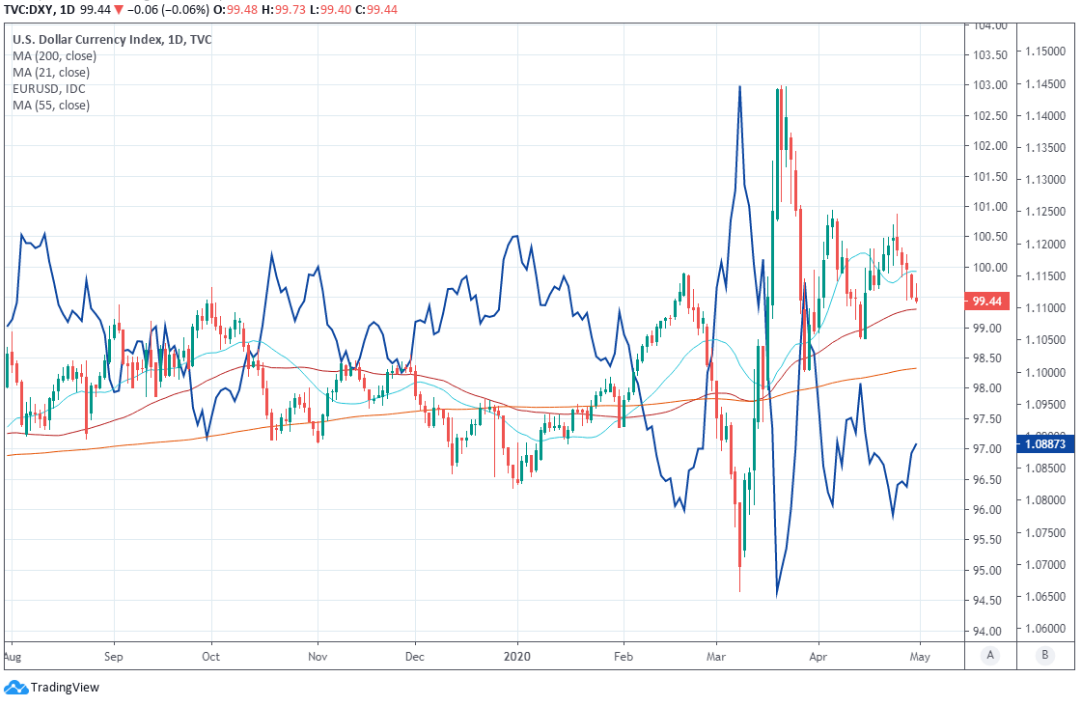Dollar Looks for Support after Fed Pledges Whatever It Takes Ahead of ECB
- Written by: James Skinner
-

Image © European Central Bank
- GBP/USD spot at time of writing: 1.2458
- Bank transfer rates (indicative): 1.2134-1.2221
- FX specialist rates (indicative): 1.2283-1.2358 >> More information
The Dollar was attempting to stabilise on Thursday after suffering broad losses overnight in response to the latest Federal Reserve (Fed) policy statement and clinical trials results for Gilead Sciences' remdisivir, although its trajectory into month-end could now be at the discretion of the European Central Bank (ECB)
Currency markets were choppy Thursday, leading the Dollar Index to alternate between fractional gains and losses following the latest Fed update and ahead of an ECB policy announcement that's key to where both the Euro-to-Dollar rate and Dollar Index end the month. The ICE Dollar Index has risen 0.35% for April and the Euro-to-Dollar rate has fallen -1.33% and was trading 0.05% higher around 1.0882 Thursday. The Pound-Dollar rate was down -0.09% at 1.2458.
This is after the Federal Reserve made no changes to its multiple programmes that offer monetary support to U.S. companies and households on Wednesday but told markets in an unambiguous manner that it stands ready to provide whatever financing is necessary to backstop the economy and set it on the road to recovery once the pandemic is brought under control.
The bank left the Federal Funds rate range at 0%-to-0.25% and reaffirmed that it will buy government bonds as well as corporate debt and securitised mortgages "in the amounts needed to support smooth market functioning, thereby fostering effective transmission of monetary policy to broader financial conditions."
Above: Pound-to-Dollar rate at daily intervals alongside Euro-to-Dollar rate (blue line, righthand axis).
"Reading between the lines, we think Powell is putting the ball squarely in the court of Congress and fiscal policy, while indirectly signaling that the Fed will accommodate such spending through its ongoing asset purchases," says Bill Diviney, an economist at ABN Amro.
Chairman Jerome Powell also said at the press conference that "more likely needs to be done" before telling reporters that "now is not the time to be concerned about federal debt" before indicating the bank will step in to support the government if necessary.
"I have never heard those words uttered by a central banker ever (let alone the Fed Chair). We truly are in a new and bizarre era," says Bipan Rai, North American head of FX strategy at CIBC Capital Markets. "The USD is down for the fifth session in a row as markets look towards month-end flows. The increase in duration extension for US bond benchmarks implies that we’re likely to see large UST buying which should support the USD."
The Fed has ruled out any withdrawal of support for the economy until its "has weathered recent events and is on track to achieve its maximum employment and price stability goals."
"Powell was market friendly in that he indicated that more support from both Congress and the Fed was likely to be needed, but he offered few specifics, noting only that the Committee felt that policy was properly geared at this time and that officials will need to be “quite confident” about a favorable outlook before they consider a firmer stance. He also noted that officials will be in no hurry to raise interest rates," says Michael Moran at Daiwa Capital Markets.
Above: Federal Reserve balance sheet. Source: Federal Reserve Bank of St. Louis.
The Fed's language made clear it's willing to provide whatever amount of Dollars is necessary to get the world's largest economy through the current crisis, at a time when the bank has already expanded its balance sheet by more than 50% to $6.1 trillion in just two months. That's a 50% increase in the volume of Dollars washing around the markets and something analysts increasingly expect to eventually bite the greenback, which could have to do with why the U.S. currency weakened overnight.
"The Fed’s policy response has been effective so far in improving market functioning and dampening US dollar strength," says Lee Hardman, a currency analyst at MUFG. "The latest positive catalyst for improving in risk sentiment were reports indicating that Gilead Sciences Inc’s experimental drug remdesivir could prove an effective treatment for COVID-19."
The Dollar weakened across the board overnight and into Thursday but was steadying early in the European session ahead of GDP data from the Eurozone, due around 10:00 and the latest European Central Bank policy decision at 12:45. The GDP data risks sinking the Euro-to-Dollar rate in a move that could be exacerbated unless the ECB commits firmly to standing behind the 'periphery' bond markets that have seen yields spike sharply in recent weeks amid fresh debt sustainability concerns.
"The 4.8% drop in first quarter GDP was a bit worse than we expected," says Ian Shepherdson, chief economist at Pantheon Macroeconomics. "The first quarter is now ancient history, and for now we're sticking to our view that Q2 GDP will drop at an annualized rate of about 30%, but we're very open to the idea that this guesstimate, based mostly on the number of job losses, will have to change significantly. Either way, though, it will be horrific."
Above: Dollar Index at daily intervals alongside Euro-to-Dollar rate (blue line, righthand axis).
The Fed's April policy decision came after the the Bureau of Economic Analysis said the world's largest economy shrank by -4.8% last quarter, a far larger fall than the -4% anticipated by the consensus. The same consensus supposedly favours a -3.7% contraction for the Eurozone at 10:00 which would be the largest decline since early 2009.
That's a lesser hit than was seen as well as expected in the U.S., but for an economy that was weaker to begin with, quicker to contract the coronavirus and which has spent longer under the draconian kinds of 'lockdown' inspired by China's response to the pneumonia-inducing disease.
There's only one coronavirus-plagued European economy that consensus expects to do worse than the U.S. Thursday and that's Italy, but only narrowly so given expectations for a -5% decline when the Italian National Institute of Statistics releases its number at 11:00. Italy, Spain, Germany and France all came to a standstill well before the streets of New York became desolate.
"More interesting is whether the ECB plans to move more aggressively to reduce sovereign bond yield spreads across the EU, a move that quickly gets the ECB into a political hot seat if it goes all-in. Such a move could support the euro, and the lack thereof could see further pressure on the single currency," says Steen Jakobsen, chief economist at Saxo Bank.













